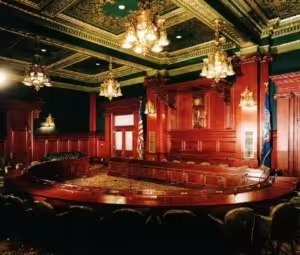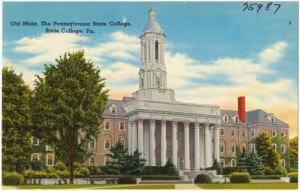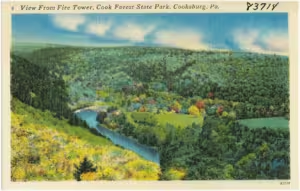Chapter 3: Pennsylvania Academy of Science in the 1920s
The Roaring 1920s
The 1920s in Pennsylvania was a time of Jazz music, Prohibition, and a time of change in the scientific world coming out of the destruction of World War I. Pennsylvania, already a leader in industrial innovation, with its steel and mining industries, started to branch out into scientific exploration. Pennsylvania universities, who were known for classical learning, started to transform into hubs of scientific research. Beyond the universities, were industrial laboratories pursuing technological advancement and becoming places of invention in their own right. Both of these forces together made Pennsylvania fertile ground for a scientific renaissance.
Contributions of the Universities
The University of Pennsylvania, a founding institution of the Academy, made significant advancements in the fields of physics, chemistry, medicine, and engineering becoming a leader in scientific research. Carnegie-Mellon University in Pittsburgh, was in its second decade and had established itself as a place for hands on learning, focusing on science and engineering. Lehigh University had an exceptional engineering program and achieved advancements in metallurgy, materials science, and other engineering.
Contributions of Industry
The Westinghouse Electric Corporation, in Pittsburgh, helped to develop household appliances, better electric power generation, and transportation systems. Bell Telephone Laboratories, located just across the line in New Jersey, had a great influence in Pennsylvania and helped to develop the transistor and furthered the advancement of communications.
The Pennsylvania Academy of Science Forms in 1924
It was in this atmosphere that the Pennsylvania Academy of Science came into existence. The Academy helped to forge the dissemination of knowledge from governmental, academic, and industrial research into a cohesive whole. Academic and governmental institutions provided the theoretical foundations, while industrial labs translated the information into practical applications.
Getting to the First Meetings of the Academy
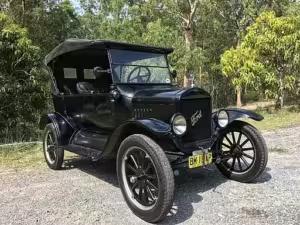
1924 Ford Model T — ModelTMitch, CC BY-SA 4.0, via Wikimedia Commons
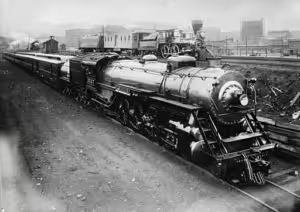
1862 train in background and 1924 train in foreground — Bain News Service, Public domain, via Wikimedia Commons
Scientists attending the first meetings of the Academy in the 1920s depending on where they were coming from, would have had a long journey getting to Harrisburg. To use the first Academy president, Otto Jennings, as an example, if he had traveled by train to Harrisburg from Pittsburgh where he lived and worked, it would have taken approximately 5-6 hours. If by car in a brand new, 1924 Ford Model T, it would have taken at least 10 hours in the best of conditions, and much longer if you had a flat tire(s). However, the early members would have thought this to be an improvement. Before the time of cars, say in 1880, it would have taken 12-15 hours by train to go from Pittsburgh to Harrisburg and vice versa. By horse and buggy, it would have likely taken days. In 2024, it only takes a little more than 3 hours by car.
The Time of the Meetings
Meetings of the Pennsylvania Academy of Science were held on Easter weekend, a fact which was written into the 1925 Constitution of the Academy. Easter weekend was chosen because it was the one time of the year when there were two successive holidays together. During this time, the members of the Academy would have had six day work weeks, with only Sunday off. Vacations were rare and most people did not have them. The idea of having weekends off did not begin on a large scale until 1938 when the Fair Labor Standards Act was passed. Compare this today, where the Academy never has the meeting on Easter weekend.
Meetings of the Academy in the 1920s
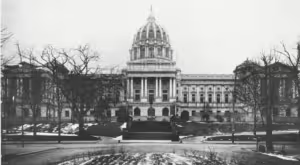
Pennsylvania State Capitol in 1906 — See page for author, Public domain, via Wikimedia Commons
The first few meetings of the academy took place and around the State Capitol. Locations included the Senate Caucus Room and the South Office Building, now called the Irvin Office Building. In 1928, the meeting was held in the western part of the state at the Carnegie Museum in Pittsburgh. The 1929 meeting was moved to the center of the state to the Pennsylvania State College in State College.
Highlights of the Meetings
During the 1920s, there were two main meetings for the Academy. An annual meeting that was held in the spring during Easter weekend and a meeting in the summer that involved field trips to places of scientific interest in the area, except for the 1925, where two Executive committee meetings were held. Besides the field trips, these summer meeting were used to welcome new members into membership.
1st Annual Meeting: April 10-11, 1925 (Senate Caucus Room in Harrisburg, PA): This year marked the first annual meeting of the academy. The main highlight of this meeting was the adoption of the Academy Constitution (Appendix I). The keynote presentation was “The Basis of Plant Geography in Pennsylvania” by Otto Jennings (The Gazette Times, 1925).
Summer Meetings: June 16, 1925 and December 18, 1925 (Locations unknown): The Academy had an Executive meeting on June 16, 1925 to replace Frank D. Kern, who resigned, as Treasurer with H.W. Thurston. On December 18, 1925 another Executive committee was held to determine the location of the 1926 spring meeting and fill a vacancy in the Executive committee.
2nd Annual Meeting: April 9, 1926 (Senate Caucus Room in Harrisburg, PA): Highlights of this meeting included papers by Dr. A. Silverman of the University of Pittsburgh, who stated that Pennsylvania makes enough plate glass to windshield the equator and is the most important glass manufacturing center in the world. Dr. Benjamin Miller of Lehigh University, also spoke on rock formations in Pennsylvania and their role in the cement and steel industries. Dr. Otto Jennings spoke on the range limites of Western Pennsylvania plants.
Summer Meeting: August 13-14, 1926 (Town park of Benton, PA): The Academy met at the town park of Benton, PA (Columbia County) and was presided over by President Norman Stewart. During this time, the Academy met with 4 people from the Wyoming Valley Historical Society looking for funding for preservation efforts of Wyoming Valley historical places. Papers were also given during this meeting. On Saturday, August 14, 1926, the members went to Kitchen Creek Falls on North Mountain near Redbank.
3rd Annual Meeting: April 16, 1927 (South Office Building of the Capitol in Harrisburg, PA): Note: the South Office Building is now called the Irvin Office Building. Highlights of this meeting included a paper by Dr. H.M. Johnston of the Carnegie Institute of Industrial Research, who spoke on sleep studies of University of Pittsburgh students.
Summer Meeting: August 6, 1927 (Nature Study Camp of the Pennsylvania State College in Seven Mountains): During this meeting the Academy members had a field trip to Allen Seegar Monument, Bear Mountain, and Bear Meadows.
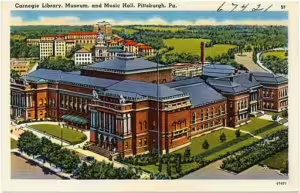
Carnegie Library, ca. 1930-1945 — Pub. by Mullen Brothers, Pittsburgh, PA. “Tichnor Quality Views,” Reg. U. S. Pat. Off. Made Only by Tichnor Bros., Inc., Boston, Mass., Public domain, via Wikimedia Commons
4th Annual Meeting: April 6-7, 1928 (Carnegie Museum, Pittsburgh, PA): Academy members were welcomed by Dr. A. Avinoff, who was the director of the Museum. Dr. E.R. Wiedlein, Director of the Mellon Institute, gave a paper on “The Present Trend of Scientific Research.”
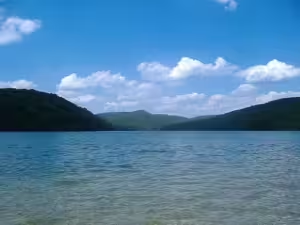
Lake at Michaux State Forest — Monobi, CC BY-SA 3.0, via Wikimedia Commons
Summer Meeting: August 10-11, 1928 (Pennsylvania State Forest School in Mont Alto): During this meeting Academy members toured Mont Alto and Michaux Forest. The evening lecture was given by George S. Perry, who spoke on “The Forests of the Scandinavian Peninsula.”
5th Annual Meeting: March 30, 1929 (Pennsylvania State College, State College, PA): This meeting featured a field trip to a limestone quarry in Bellefonte, PA containing Bentonite and a trip to the Crystal Structure Laboratory at the Pennsylvania State College. The annual dinner of the Academy was held at the University Club. A resolution on the state flower and tree was discussed (more information on the section on Academy Resolutions).
Summer Meeting: July 26-27, 1929 (Cook Forest in Clarion County): Academy members toured the newly formed Cook Forest and were hosted by E.M. Gress of the Pennsylvania Department of Agriculture, who talked about the myths of the plants in the park. The members were addressed by C.E. Zerby, the District Forester who talked about the History of Cook State Forest. The forest became a property of the state on January 1, 1929. Otto Jennings described the evolution of the plant cover in the region.
Go to Chapter 4: Pennsylvania Academy of Science in the 1930s
